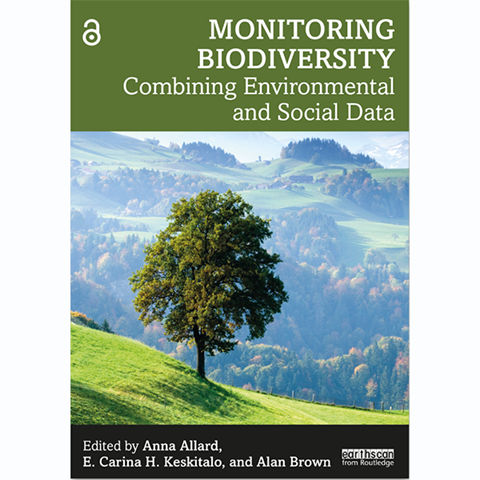Monitoring Biodiversity: Combining Environmental and Social Data is published by Routledge, an international book publisher specialising in academic literature. Targeting people working in environmental monitoring and university students, particularly in Europe, the book's 18 chapters are written by 47 authors from Sweden, the rest of Europe and Australia. Editors are Anna Allard from SLU, Carina Keskitalo from Umeå University and SLU, and Alan Brown from Wales.
-Many of the authors are colleagues of mine at SLU's Department of Forest Resource Management, and to celebrate that we have finally reached our goal, we are organising a short presentation in connection with the book release on 31 March,' says Anna Allard. We have invited our co-authors to participate via link, but others are also welcome.
A new knowledge reference
-The book fills a gap as it describes the new requirements for biodiversity reporting, and presents at the same time solutions that will meet the new requirements. The idea is that it will serve as a knowledge reference both for students and for people working with environmental monitoring at national or EU level," says Anna Allard.
Biodiversity and landscape monitoring is undergoing rapid change. Remote sensing, i.e. measurements using sensors on satellites, aeroplanes and drones, among others, has been used partly as a complement to manual observations and field measurements, and is now becoming increasingly widespread as a platform for data collection. In addition, most remote sensing data is now freely available and is being utilised at a rapidly increasing rate. This, in turn, has changed reporting requirements to the EU and thus the authorities' monitoring requirements, and often digital maps or models are now required to show not only what and how much has changed, but also where. These developments mean that many competences are needed in monitoring, from field survey experts to database and GIS experts.
Accounting for the humans, their behaviours and reactions are factors, often forgotten in biodiversity monitoring programmes. Much of the understanding of landscape changes, or why some policy decisions never reach the desired effects are due to human behaviour, culture and heritage. Data gathering of human behaviour in the context of monitoring biodiversity are done in the field of Social Sciences. The book picks up and discuss some common ways as well as providing examples.
Monitoring Biodiversity provides a new and exciting picture of the importance of biodiversity monitoring today and how it is carried out. It also shows how new technologies and software applications are maturing rapidly and can complement the 'best practices' that have been developed over time in traditional field activities, without breaking the continuity of monitoring.
Environmental monitoring is a key component of the work on several of Sweden's environmental objectives and the adaptation to the international action plan known as Agenda 2030, with goals for transitioning to a sustainable society for people, planet and prosperity. Environmental monitoring also helps us understand changes in the environment and supports policy development. Taking an interdisciplinary approach, the book begins by discussing monitoring as an established activity and examines its economic and technical challenges. It presents different approaches and differences between countries and explains how new political objectives or economic conditions can affect the way monitoring has been designed. The huge range of methods - from statistical design to remote sensing, interviews, surveys and new ways of facilitating visualisation and modelling - underlines the maturity and diversity of today's surveillance. The book concludes with several problem-based chapters on environmental monitoring in specific scenarios, including urban and marine environments and watersheds.
